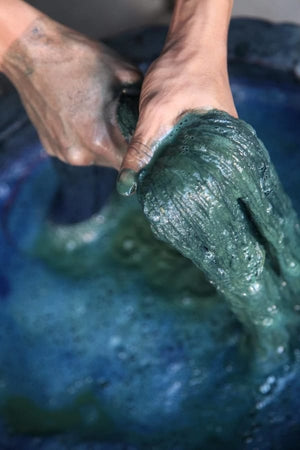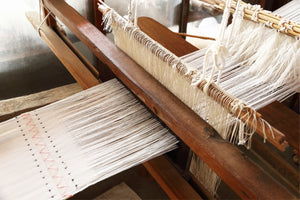The rise of sustainable fashion has created a huge appetite for handmade and hand-loomed items. There’s something extra special about handmade pieces; the level of artistry achieved is unique, and you know the person who made it put genuine thought, love and passion into it.
No wonder handloom fabrics are all the rage now! They truly deserve the limelight and your appreciation grows once you understand how they are made.
So what are handloom fabrics? How are they made? And what are their advantages and disadvantages?
Whether you already are a handloom lover or just handloom curious, we have the answers! We’re taking it back to basics by shedding some light on the history, use and benefits of handloom fabrics.
Let’s dig in!

What are handloom fabrics?
Handloom fabrics are handwoven fabrics created on a weaving device called a loom. The process involves entwining a set of vertical threads, the ‘warp”, with a set of horizontal threads, the ‘weft”.
The loom holds the warp threads under tension to facilitate the interweaving of the weft threads over and above the warp using a weaving shuttle. This is done repeatedly to create the handloom fabric.
Handloom weaving is a labour of love as much as it’s a source of livelihood. It requires utmost patience, artistry, and technical skills not to mention physical strength!
The weaver’s hand is at the heart of this intricate process. They select the yarn, pattern, colour, texture, and precise technique to create their desired aesthetic.
The fabric carries the energy and personality of the weaver and it becomes part of the garment’s story.

The History of Handloom
The earliest known loom is thought to have developed in China, during the invention of sericulture (silk production). Although probably more a myth than reality, the story goes that both the production of silk and it’s weaving on a loom was invented by Lady His-Ling-Shih, the wife of the Yellow Emperor, who is thought to have ruled China around 3,000 BC (although his existence is still debated!).
As looming spread from China, many other styles and forms of handloom design emerged across Southeast Asian countries including Thailand, Cambodia, Indonesia, Lao, Brunei, Malaysia and more. Although even today, many looms maintain similar working principles to some of the earliest looms invented!
One of the biggest developments in looming came in 1801, when Joseph-Marie Jacquard, invented the jacquard machine. A device fitted to a loom that used punch-holes to create complicated patterns and designs.
This invention led to highly-valued pattern cloth becoming much more affordable to the masses. When the jacquard loom reached India in the mid-19th century, it became the preferred choice of weavers and the textile industry took off. Indian weaves were hugely popular around the world and were exported to Egypt, Arabia and China.
Interestingly, the Jacquard machine is also behind the inspiration for punch-card computers and a main evolutionary stage in the development of the power loom.
Source: canva.com
The threat of power looms
The handloom industry was booming until the power loom showed up. The electrical powered machine produces 5 times more fabric and displaces 14 handloom weavers with each job created.
Power looms were, and still are, a fantastic invention. Allowing clothing and fashionable designs available to all, not just high society. However, this unrelenting competition has put the handloom industry in an existential crisis, and many weavers have been gradually switching over to power-driven looms for fear of losing work.
The good news is that there are millions of weavers around the world still pursuing their passion for handlooms. The onset of the slow fashion movement has meant many consumers seeking handloom fabrics that support both the planet and the people that make them.
More renowed fashion designers, such as Atelier Pichita and Sabyasachi Mukherjee, are also bringing handlooms back into fashion by featuring them in their collections and giving them a modern and contemporary appeal.
The covid-19 pandemic has also led to more people trying hand-looming from home as handcrafting became extremely popular during lockdowns. The beauty of handloom fabrics is being appreciated again across all forms of art and design, from wall-art, to interior design, to fashion!
Types of handloom fabrics
Handloom fabrics come in an array of rich colors, patterns, designs and textures. Some are even jazzed up with sequins, beads, mirrors or cowrie shells!
Handlooms have a direct connection to the culture and people of each community they come from. The motifs, patterns, and techniques are passed down in families from one generation to the other and form an identity and cultural artifact. As a result, they’re used extensively in traditional dress such as the Indian sari and Chut thai as well as everyday modern fashion wear.
For example, mudmee silk is a well-known handwoven Thai fabric that is native to the northern province of Lamphun in Thailand. The warps and weft threads are tie-dyed before weaving resulting in bright colored handlooms with traditional motifs inspired by local beliefs and surrounding nature.

Rare & Fair's handloom Mudmee Fabric
Banarasi brocade is one of the finest handwoven fabrics which comes from Vanarasi city in northern India. It’s made with gold and silver silk threads and engraved with lavish embroidery patterns.
Endek is also an exquisite handloom from Bali made of cotton or silk often worn as formal or celebratory clothing.
Handlooms are also found in a wide range of stunning home decorative accessories such as wall hangings, pillow covers, bedspreads, lampshades, rugs, table clothes and many more. If you love the bohemian look, handlooms can add a worldly charm to your nest!
Advantages of handloom fabrics
- Uniqueness
No two hand-loomed fabrics are the same and that’s the beauty of the fabric. Each item is a work of art and a unique display of craftsmanship that reflects the weaver’s hard work, love, passion and persistence.
To this day, there are intricate handloom patterns that are still beyond the scope of machine-made weaves!
- Variety
Handloom allows the weaver to have total control of the creative process which encourages them to explore new ideas and come up with innovative weaving patterns and designs.
On the other hand, power looms are repetitive and only allow the weaver to create a replica of one particular design.
- Quality
Handloom fabrics are generally made with high quality natural fibres like cotton, linen, silk, and wool which are resilient and last for a long time. What’s more, weavers pay close attention to detail (far more than mass produced products) to ensure they produce the best, long-lasting, fabric.
- Comfort
Handlooms feel significantly better against the skin compared to power looms, especially if made with synthetic fibers like polyester, nylon and rayon. Handlooms are also more absorbent and breathable, which makes them the go-to fabric for those warmer summer days!
- Skill preservation
Handloom exemplifies the richness and diversity of the community it emanates from. Their identity is woven into the cloth they produce, which is determined by indigenous techniques, materials and design passed down generations.
The art of handloom creates a sense of purpose and community and ensures valuable traditions do not disappear.
6. Important source of livelihood
Handloom provides a source of livelihood for many rural communities. In India, the industry is the second-largest employer after agriculture. Remarkably, 77% of weavers are women and handloom allows them to be economically independent and self-sufficient.
- Eco-friendly
The handloom industry is a perfect example of sustainable production. Every step of the handloom process is sustainable, from installation, fabric choice, dyeing and weaving. The natural fibers used are biodegradable and are not produced with many chemicals and resources.
- Fabric dyes are usually sourced from natural ingredients such as turmeric, indigo, henna, dogwood bark, and dandelion which are completely safe for the skin and the environment.
- The fabrics are often made to order which means less waste.
- Leftover materials are used creatively for other designs.
- The loom is manually operated - no energy or water is required and no carbon emissions are released.
- Weaving is mostly done in weavers’ homes where the working conditions and wages are ideal compared to power loom factories.

Disadvantages of handloom fabrics
- Imperfections
Hand-woven fabrics are bound to have some defects not usually present in industrially produced fabric on account of being made by hand. These “imperfections” are intrinsic to the beauty of the textile and give them an ethnic appeal.
- Limited quantities
When it comes to meeting mass demand, power looms outdo handlooms many times over as weavers can only produce a limited amount of fabric. The latest data shows productivity per loom per day is around 5.12 meters in India while one power loom can produce 50 meters of fabric a day.
- Expensive
Handloom fabrics can be a bit on the pricey side. Weavers put a lot of focus on delivering high quality products made with the right material, design texture and color, which costs time and money.
- Time consuming and laborious
Since handloom is reliant on human labor, it takes a lot longer to create a fabric. Some intricate patterns and designs such as the Patola saree can take 6 months to 2 years to complete.
How to tell if your handloom fabric is legit
If you’re looking for authentic handloom, it might be difficult to differentiate the real from the fake. Don’t worry, we’ve got you!
Here are a few telltale signs to look out for the next time you go handloom shopping.
- Look at the weave: Handlooms have slight imperfections while power looms are even due to uniform thread spacing,
- Feel it with your hands: Handlooms are soft, plush and drape effortlessly. Power looms are stiff with an ironed out feel due to the compact weaving.
- Check the ends: Handlooms are slightly wavy at the ends and power looms are perfectly even.
- Compare the prices: Handlooms are significantly more expensive since they are handcrafted with pure organic materials.
Handloom Fabrics - Final thoughts
Although the practice of handloom is viewed as a fading art, there’s still hope for the future of the industry. There have been initiatives over the years that have increased the visibility and viability of the craft.
Social media awareness campaigns through popular hashtags such as #IloveHandloom and #vocalforhandloom have ignited interest in handloom fabrics especially among Millennials and Gen Zs.
The Indian government has also declared August 7th the National Handloom Day to celebrate the extraordinary skills of weavers and encourage people to buy the handloom products.
With the growing demand for sustainable fashion around the world, the handloom industry can play a big role in that transition.
Handlooms are more than just fabrics, they’re monuments that carry so much history, culture and heritage that’s worth preserving.
They’re a wonderful thing to have in this overly homogenized world!
So, go ahead and grab yourself a handloom item today!



